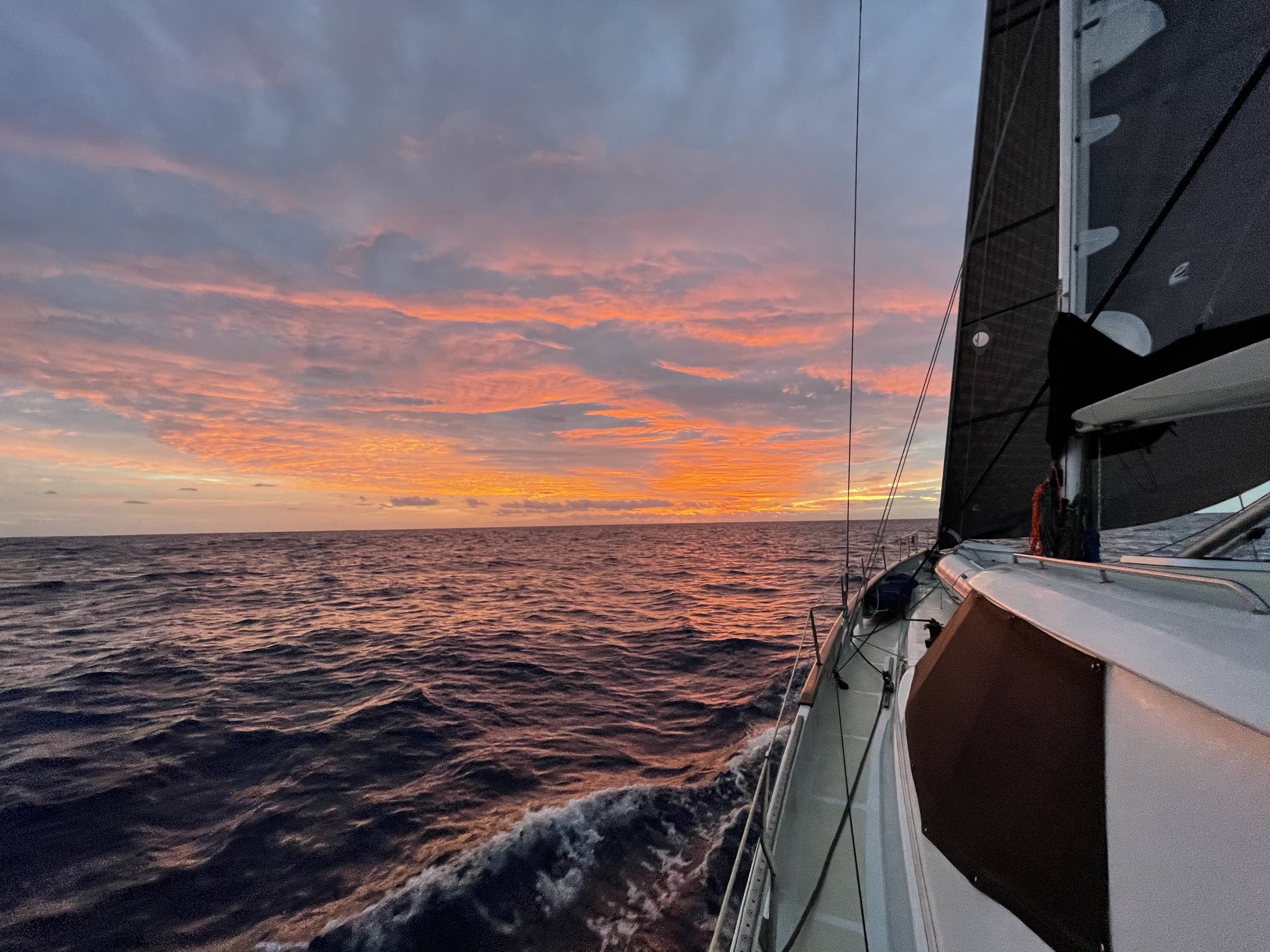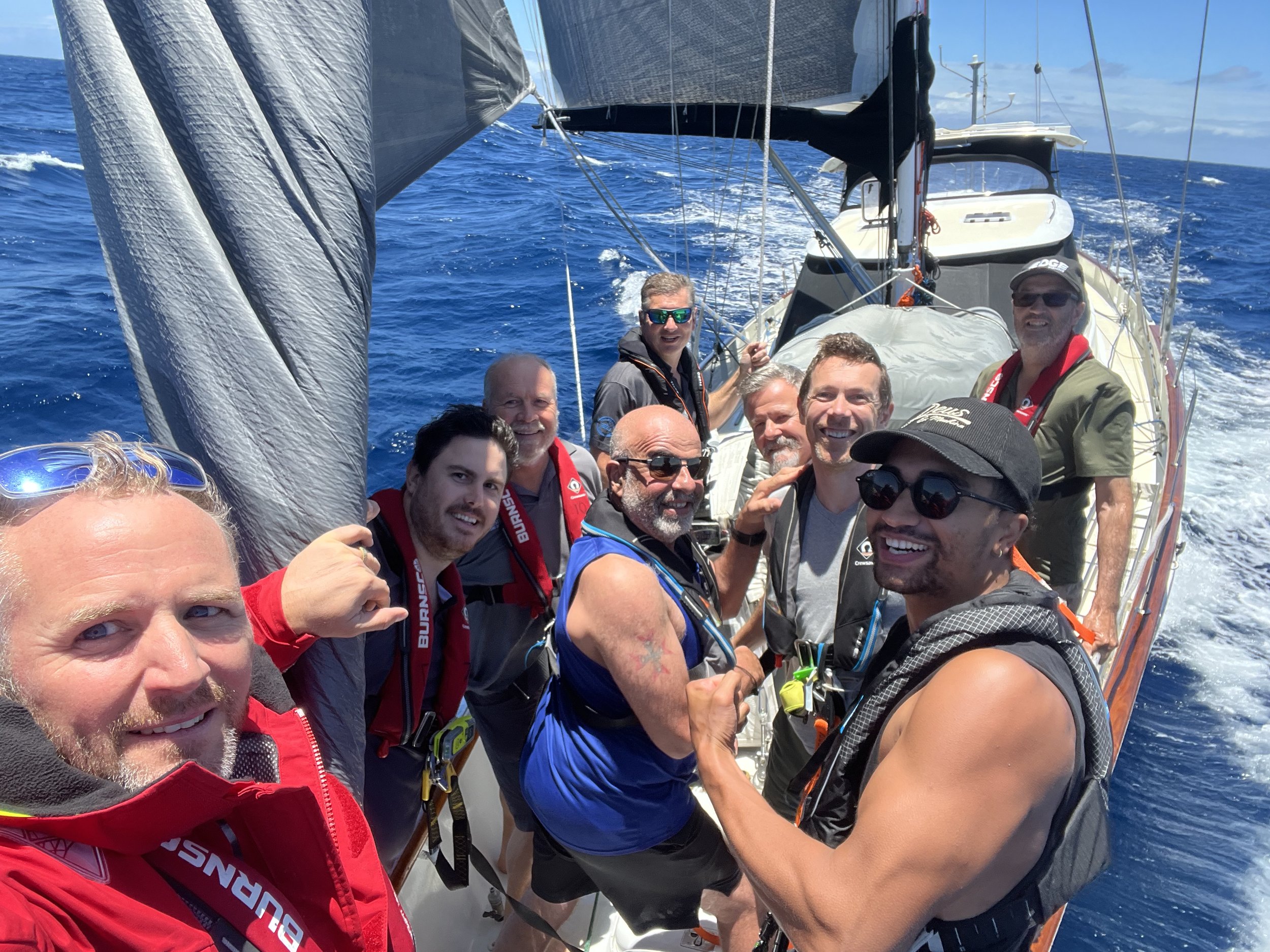Join our crew, sail from Hobart to opua to Auckland
16 days / cat O sailing passage / 1,530nm
Overview
The Hobart to Opua to Auckland Ocean Passage is an epic, Category 0 offshore sailing adventure, taking us from Hobart, Tasmania, across the Tasman Sea, before making landfall in Opua, Bay of Islands, and continuing down the New Zealand coastline to Auckland—the City of Sails.
Crossing the Tasman Sea is one of the most revered and challenging ocean passages in the world. With no landmass for more than 2,500 nautical miles between Antarctica and the Pacific Islands, the ocean swell has unlimited fetch, building into powerful rolling seas. This stretch of water is infamous for its fast-changing weather systems, making it a true bucket-list passage for offshore sailors.
While the Tasman’s reputation for extreme conditions is well-earned, this passage is carefully timed for optimal weather conditions, ensuring a safe and exhilarating crossing. Our skippers have crossed the Tasman more than 20 times (two solo) and will navigate using real-time weather routing, course adjustments, and expert seamanship to make this a rewarding and unforgettable ocean adventure.
After arriving in Opua, Bay of Islands, we’ll complete customs clearance and enjoy a stopover, before cruising the final leg down the east coast to Auckland, stopping at three to four remote islands to soak in New Zealand’s spectacular coastline. This voyage offers incredible ocean sailing, stunning night skies, phosphorescent waters, and unparalleled tranquility, making it an experience like no other.
Passage Overview
We’ll depart Hobart, spending our first day clearing the Tasmanian coastline, before setting a direct course across the Tasman Sea towards Cape Reinga. The first few days will allow us to settle into the rhythm of offshore sailing, adjusting to life at sea as we navigate the vast expanse of the open ocean. Expect to experience long rolling swells, clear horizons, and a deep sense of solitude, with no other vessels in sight for most of the passage.
The Tasman Sea crossing demands a well-prepared yacht, skilled seamanship, and strategic weather routing. The conditions can range from fast downwind surfing on ocean swells to moderate breezes and glassy calms, requiring constant sail adjustments and course planning. Our skippers will carefully monitor live weather updates, ensuring the safest and most efficient route.
As we approach Cape Reinga, the northernmost tip of New Zealand, the thrill of landfall sets in. From here, we’ll sail the final 80 nautical miles to Opua, where we’ll clear customs and take a well-earned rest stop in the sheltered waters of the Bay of Islands.
Exploring the Bay of Islands & Coastal Stopovers
After our Tasman crossing, we’ll slow down and take time to explore the stunning anchorages and island landscapes of New Zealand’s east coast. We’ll visit a selection of remote and beautiful locations, depending on weather conditions and crew preference on our way to Auckland.
Opua Marina – Gateway to the Bay of Islands
Opua Marina is a bustling hub for sailors, offering excellent facilities, a welcoming maritime community, and stunning surroundings. It’s the first port of entry for many vessels arriving in New Zealand, making it an ideal spot to clear customs and refresh after an ocean passage. The area boasts local shops, waterfront cafés, and access to the lush Opua Forest, perfect for a short hike or a relaxing break before continuing our journey.
Roberton Island – Twin Lagoons & Rich History
Roberton Island, also known as Motuarohia Island, is a historically significant stop, first charted by Captain Cook. Its famous twin lagoons create a stunning natural anchorage, perfect for snorkelling, paddleboarding, and exploring ashore. The island offers incredible views from its lookout track, making it a must-visit destination in the Bay of Islands.
Urupukapuka Island – Adventure & Cultural Heritage
The largest island in the Bay of Islands, Urupukapuka is a haven for exploration, featuring pristine beaches, walking trails, and ancient Māori pa sites. Its clear waters are ideal for swimming, kayaking, and snorkelling, while its predator-free status makes it a prime spot for native birdwatching. The island’s mix of adventure and cultural history makes it a perfect stop before we continue south.
Final Leg – Sailing to Auckland
Leaving the Bay of Islands, we’ll begin our leisurely passage south, sailing down New Zealand’s spectacular east coasttoward Auckland. This final stretch offers a mix of offshore and coastal sailing, with breathtaking scenery, rich marine life, and the ever-changing backdrop of rugged cliffs, golden beaches, and deep blue waters.
As we head south, we’ll sail past Cape Brett, with its dramatic sea cliffs and the famous Hole in the Rock, a striking rock formation that has long been a symbol of this coastline. From here, we continue along the Northland coastline, passing long, untouched beaches and rolling green headlands, making for an incredibly scenic final leg of the voyage.
With the prevailing winds and ocean currents, this leg offers a mix of steady cruising and dynamic sailing, providing an opportunity to fine-tune sail handling, navigation, and seamanship. The open waters of the Pacific Ocean to the eastand the stunning shoreline to the west create a unique contrast of vast seascapes and rugged landscapes, making this passage both serene and exhilarating.
As we approach Hauraki Gulf, we’ll enter one of New Zealand’s most iconic sailing destinations, known for its idyllic islands, sheltered bays, and rich maritime history. The final miles into Auckland will be marked by the sight of Rangitoto Island, its volcanic peak standing tall over the city. Finally, we’ll make our way into Gulf Harbour Marina, where we’ll reflect on an extraordinary journey—one that has taken us from the raw, open waters of the Tasman Sea to the coastal beauty of New Zealand’s east coast, ending in the world-renowned City of Sails.
HERE’S WHAT YOU WILL EXPERIENCE ONBOARD
Safety: Familiarisation of all safety procedures, sail planning, storm preparation planning and abandon ship procedures.
Training: Use of PDF’s (Personal Flotation Devices), PLB’s (Personal Locator Beacons), safety tethers, dan buoy’s, storm drogue, liferaft and any other equipment required to ensure you remain safe in all conditions.
Personal wellbeing: Advice on how to take responsibility for managing clothing, hydration, sleep and nutrition to maintain your health and well being aboard.
Passage planning: Planning our arrival and route to safe harbour including timing with daylight (if required), weather factors, navigational hazards, communications / customs and sail/motor arrival plan.
Sailing: Hoisting, trimming and reefing both upwind (main, genoas, and jibs) and downwind sails (poled out headsails, spinnakers, gennakers and code 0’s (subject to weather).
Watch duties: Acting as watch captain (day and night), helming, navigating, checking weather and monitoring AIS and radar and for both traffic and rain squalls.
Weather: Downloading and analysing the latest weather forecasts and calculating best route to destination.
Navigation: Navigating, hazard identification, entering waypoints and calculating updated ETA’s.
Leadership: Watch roster planning, matching responsibility to experience, crew management and communication.
Review sailing calendar for all events


















